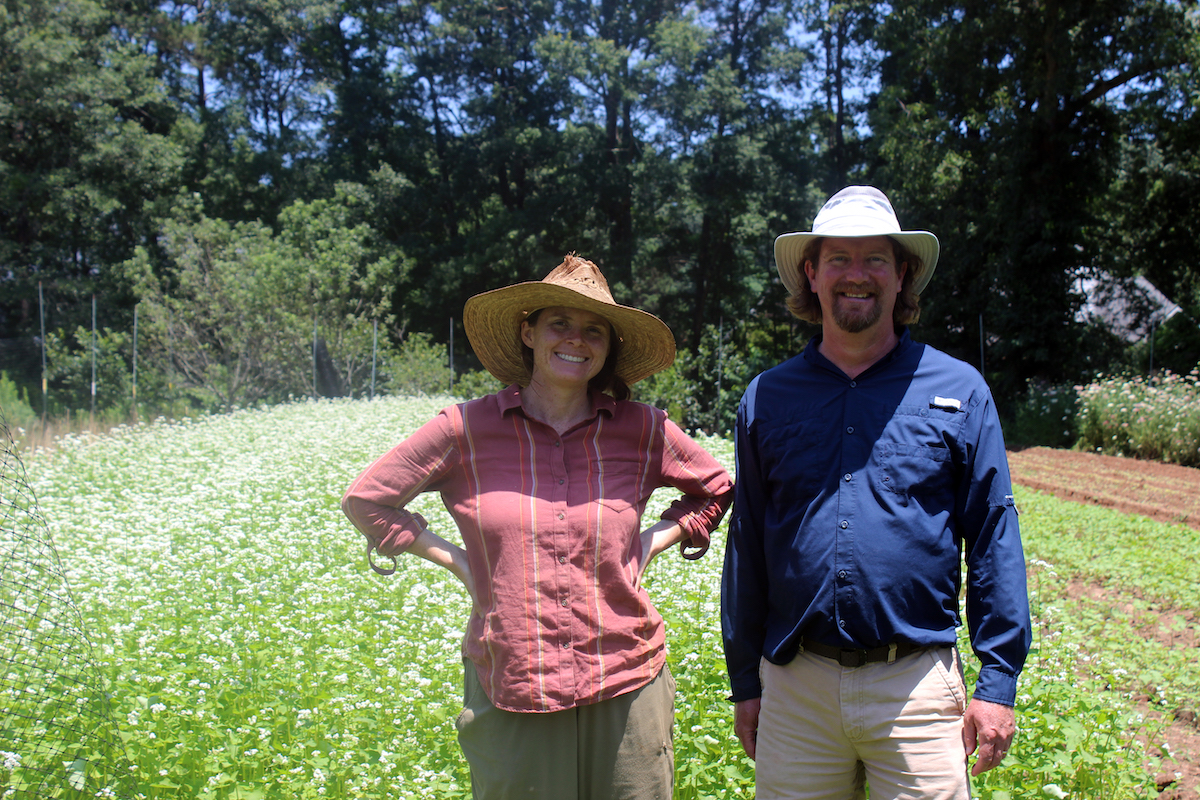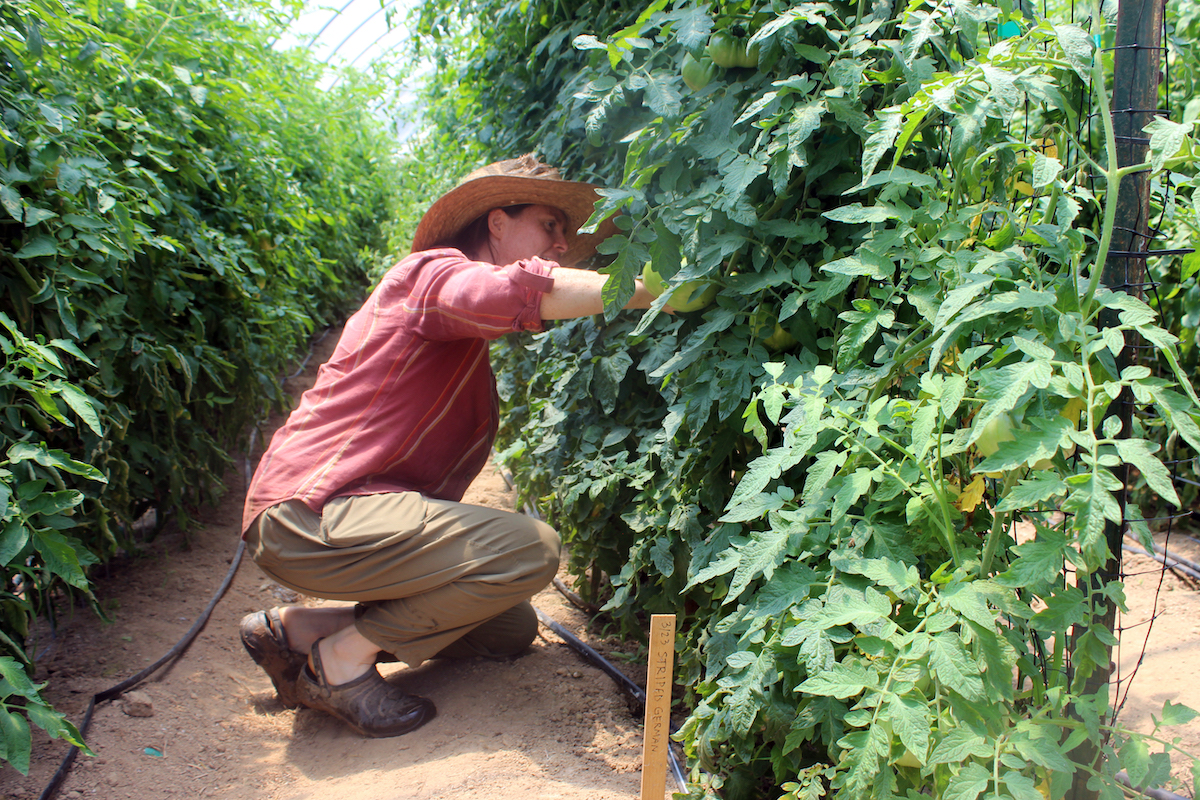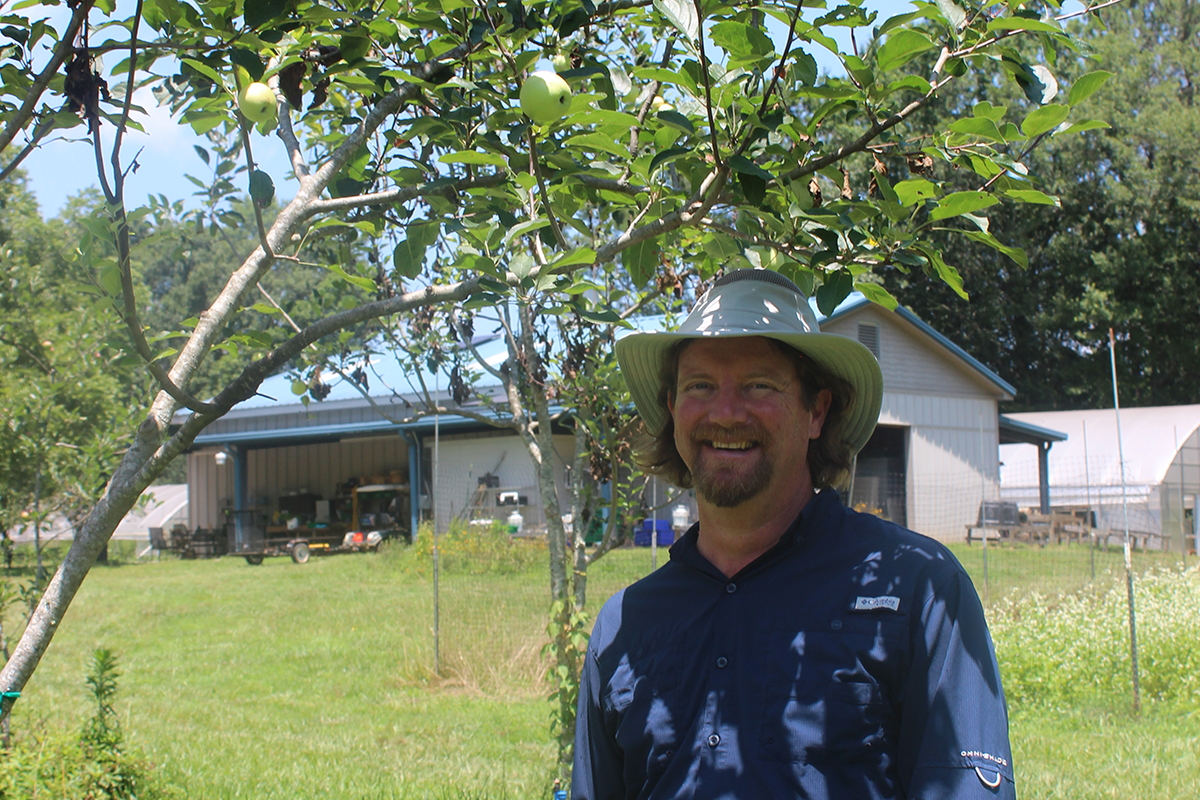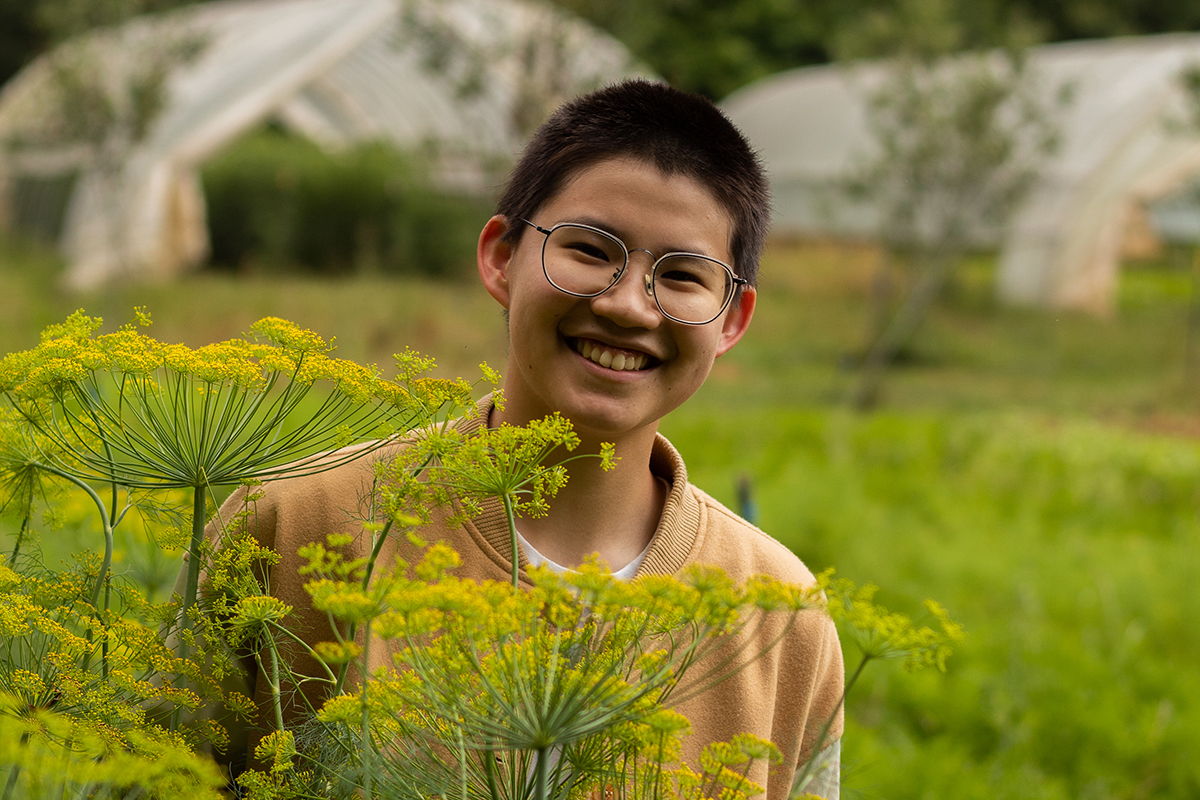Right across the street from the Oxford College campus, a farm is visible from the road. At the front are blueberry bushes and a few varieties of flowers. But what you can’t see is everything happening beyond that initial glimpse.
What’s beyond the blueberries? Flowers, fruits and vegetables are growing, being pollinated, being planted, being harvested, all tended by people who are hard at work — even in the summer, when students have gone their separate ways — to keep the ground producing, the dining hall and hospital pantries stocked, and the CSA boxes coming.
Welcome to the Oxford Organic Farm.
Readying the soil
The farm was started in 2014 to provide fresh produce for student and hospital dining along with hands-on educational experiences for students in many disciplines.
The three-acre farm is on a parcel of 11 acres — just larger than 8 football fields — and was donated to Emory by an alumnus in 2011. So when Oxford began a feasibility study for a farm space that same year, this is the land they had in mind. In January 2014, Daniel Parson was hired to start the farm in earnest. Parson held a master’s degree in plant and environmental science and 15 years of organic farming experience in Georgia and South Carolina.
“Interest in the environment drew me to be interested in organic farming; hands-on farming experience drew me back to school to learn more about what I was doing and progressed from there. Here I am. This is my dream job, and I’ve been here almost 10 years now,” says Parson.
One step at a time, Parson turned the land from a grass yard into nutrient-rich soil where crops could thrive.
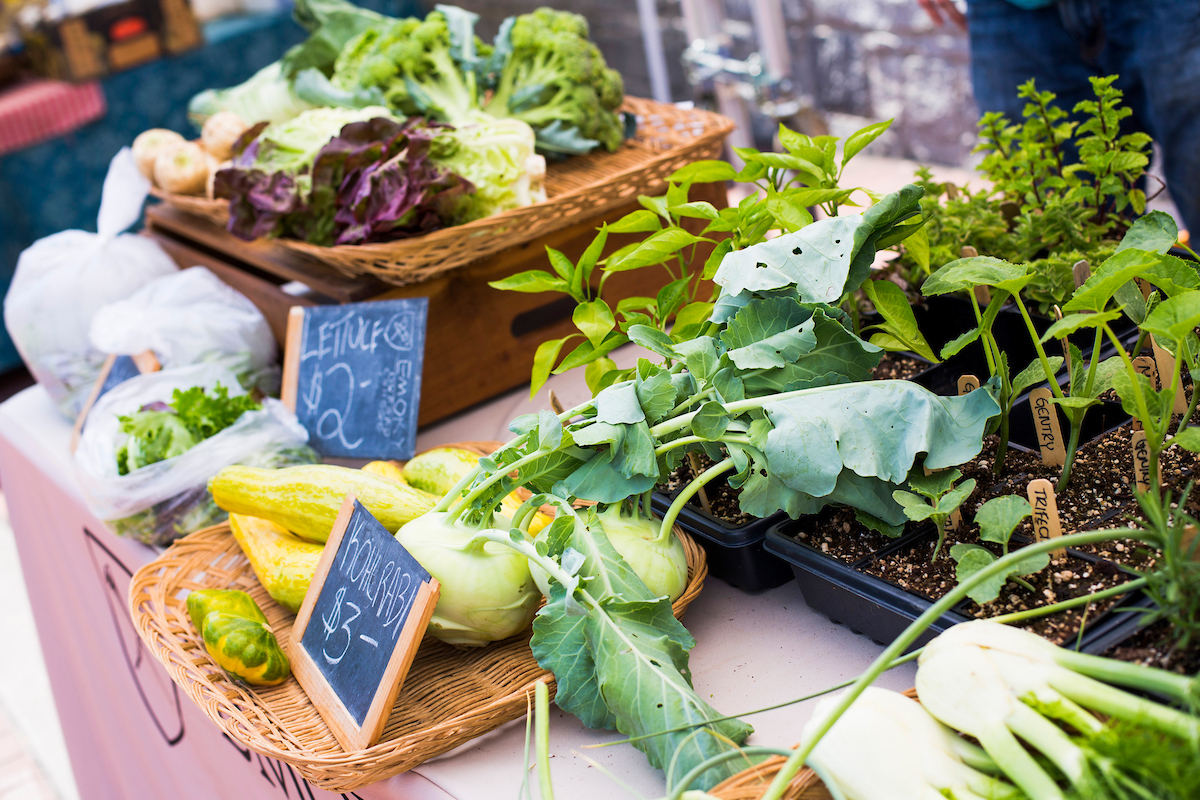
Fresh produce being sold at the Emory Farmer’s Market
Emory Photo/Video
Planting the seeds
Step one included testing and adjusting the soil, building the barn, laying out the quarter-acre fields and drilling the well. High tunnels have also been added, which act as greenhouses for crops such as tomatoes and offer some control over climate and precipitation. Unlike a traditional greenhouse, these tunnels are passively heated by the sun rather than by a gas or electric heater.
The barn and outdoor wash station are where all the post-harvest handling happens, along with washing “dishes” — the bins and buckets used across the farm. While the run-off water would normally soak the surrounding grass, it now benefits a rain garden.
“The rain garden is all native plants, and the native insects and hummingbirds love it,” Parson says. “It’s good for the ecosystem, but it also ties in with our own pest control.”
Pest control is key because organic farms cannot use chemical pesticides as conventional farms do. While pesticides derived from organic (or living) things are allowed, this isn’t used as the primary pest defense on the farm. Instead, the farm uses “integrated pest management,” a mix of using healthy plants with strong immune systems, varieties bred to be pest resistant, targeted use of approved pesticides and promoting beneficial insects. In other words, the farm intentionally supports the lifecycle of predatory insects by planting pollinator gardens, cover crops like buckwheat and sorghum sudangrass, and leaving unplanted rows between growing areas.
“If we grow a crop, we’re going to get the pests that like those crops,” Parson says. “If we provide what the relevant predators need for their life cycle, we’re going to have the predators. Not spraying is part of supporting that lifestyle. And in a way, not using pesticides opens that door to insect warfare.”
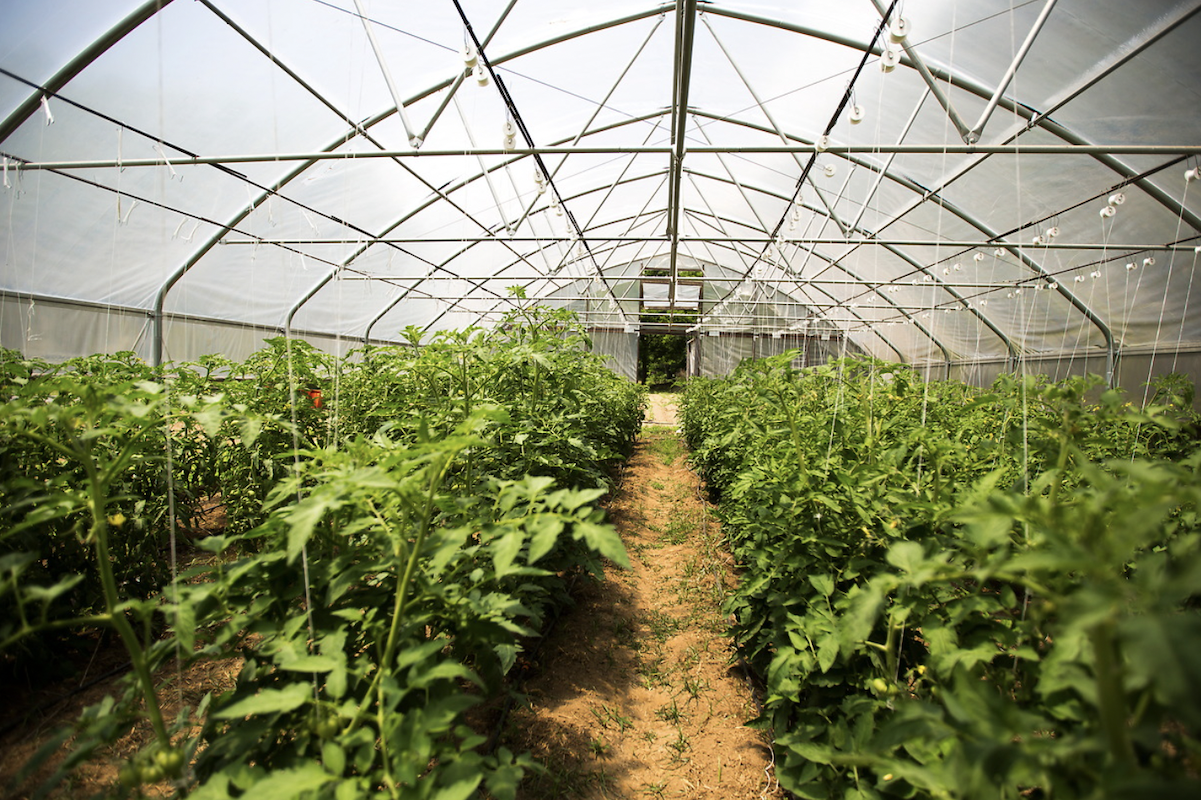
Tomato plants growing in a high tunnel, which acts as a greenhouse and provides additional climate control.
Emory Photo/Video
Making them grow
It’s obvious that without access to land, there would be no farm.
The same is true of the staff.
During the academic year, the Oxford College Farm hires 12-20 students who typically work a weekly six-hour shift. The work is open to any student at Oxford and students can work at the farm their entire time at Oxford.
In addition to Parson, the farm also employs four full-time staff: two farm apprentices, Jordan Hasty and Joanna Wright; post-harvest manager Lisa McCusker; and Catherine Reuter, the associate farmer-educator who focuses on field management.
To educate students, the farm is incorporated into the environmental sciences curriculum and works with other, perhaps less obvious, programs such as sociology, economics and creative writing. That’s how Grace Chou 24Ox 26C became involved.
Chou, who is from Cochabama, Bolivia, was introduced to the farm during an anthropology midterm in her first semester. “I didn’t know it at the time, but that midterm foreshadowed my involvement as a summer intern as well as all the ways in which the farm’s role in the Emory community can be studied anthropologically,” she says.
Her responsibilities include anything and everything related to farming. “The farm is no exception to Oxford’s liberal arts education,” Chou says. “A typical week would include harvesting five to ten different types of crops, setting up (or taking down) irrigation lines and fences, weeding, pruning plants, washing and packing vegetables, data analysis, fertilizing fields, washing bins, and planting seeds or transplanting plants.”
Research projects also call the farm home. Students from Debjani Sihi’s lab in Environmental Sciences are currently conducting research on greenhouse gasses in an okra field. It may be research, but it’s still farming, so weeding is a must.
Sharing a bountiful harvest
When it comes to both food and knowledge, the farm is ready to share.
To market their food, farm staff attend farmer’s markets in Oxford, Emory and Covington, and offer a CSA (Community Supported Agriculture) program for individuals in the area. Each week’s CSA box offers locally grown, fresh, seasonal produce and promotes sustainable agriculture. Plus, CSA subscriptions offer the farm regular, dependable income — something that’s incredibly important in an industry that depends heavily on the weather. As a bonus, the regular pick-ups offer a chance for members of the community and farm to build relationships.
“We’re certified organic, but I would really categorize it as management-intensive vegetables,” Parson laughs.
And no one who visits the farm or speaks with one of the caretakers walks away without new knowledge.
“I get excited when we talk with visitors about some of the more complex ideas,” says Reuter. “And they’ll say, ‘I never thought about that,’ or ‘I never knew that.’ That’s good — it means they’re learning something, and they’ll take it with them.”
This has been true for Chou, who started her summer internship at the farm in May. “I continue to be surprised by all the ways the farm is intertwined with different aspects of our lives,” she says, pointing to the ways she’s seen agriculture intersect with data analysis, sociology and more. “I am blown away every day by all the factors the farm needs to consider to thrive, both as an ecological system with living plants, insects, organic cycles and animals, and as a profitable business. I could go on for hours about the farm’s role in supporting local economic growth and creating tight-knit community spaces for bonding and learning.”
Parson points out that many people are surprised by the complexity involved. “One of the themes we try to convey to students is the importance of biodiversity,” he says.
Reuter finishes his sentence: “In terms of what crops we’re growing, incorporating grass pathways and leaving habitat between things. You have to approach biodiversity and sustainability consciously, and we’re doing it.”
Preparing for next season — and the one after that
Schools typically enjoy a slower pace during the summer, but it’s one of the busiest times of years for the farm. Enjoying those late-summer and fall staples requires growing during the hottest months and preparing the soil even before that.
Here’s how the rotation goes: when a cash crop (like broccoli) is harvested, the field is tilled to kill weeds and a cover crop (like buckwheat) is seeded. After the cover crop is plowed into the earth, it sits to allow the material to break down, which takes a few weeks and several rounds of tillage. Then, the field is rebedded and transplanted with the next cash crop (like sweet potatoes). These cover crops put essential nutrients and organic material back into the soil, help reduce runoff and serve as a habitat for pollinators and other insects.
Looking ahead, the climate crisis and its effect on farming are top of mind for the farm. Parson says the effect is already noticeable, but it’s brought unpredictable outcomes rather than a longer growing season.
“We are more likely to have longer warm periods during normally cold seasons, and the energy of storms is seemingly increasing,” he says. “It is these changes that present a challenge: early flowering this spring followed by freezing temperatures hurt our blueberry crop, for example. If it hadn’t been so warm, the flowers would not have bloomed. And if it hadn’t been so cold later, they would have developed normally.”
One piece of good news: the farm’s existing practices work to mitigate these meteorological changes. Growing different varieties of blueberries, for example, meant that some types were more affected by the freeze than others and the farm didn’t suffer a total loss.
Keeping rising precipitation rates in mind, the farm works to increase organic matter in the soil, which helps with too much and too little water.
“That same organic matter represents CO2 that is not in the atmosphere anymore. One million pounds of six-inch-deep soil per acre, with a 1% increase in organic matter, is five tons of carbon stored. That has a big impact,” he says.
Looking out at the farm, things seem bright. Parson says, “You can see how a lot is in production, and what isn’t in production is cover crops. Everything is humming.”
As soon as you step off the road and onto the farm, you can feel that humming for yourself — from the rustling of leaves to the washing of market-ready produce to the buzz of pollinator wings.
Get your hands dirty with gardening know-how
Daniel Parson’s top tips for someone interested in starting to grow their own produce:
- You don’t have to have a raised bed; you can plant right in your ground.
- Get a soil test and amend your soil according to that. Soil can be tested by your local extension agency, which can also give recommendations on how to adjust the nutrient levels and what will grow well in your area.
- Consider some type of crop rotation. Even in a small space, moving things around will help keep the soil healthier.


